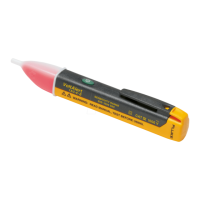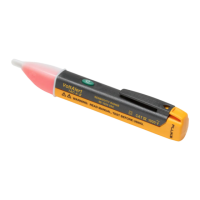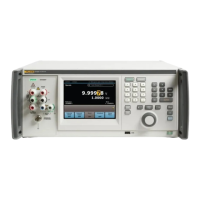Front Panel Operation
Operate and Standby Modes 4
4-13
4-16. Operate and Standby Modes
When the OPERATE annunciator is lit, the output value and function shown on the
Output Display are active at the selected terminals. When the STANDBY annunciator on
the Output Display is lit, all calibrator binding posts except GROUND are open-circuited.
To toggle between operate and standby modes, press O.
If any of the following events occur during operation, the calibrator automatically
switches to standby mode:
• The r key is pressed.
• A voltage ≥22V is selected when the previous output voltage was less than 22V.
• The output location is changed, for example by selecting an amplifier. The exception
is when the 5725A is selected for ac voltage or current, provided the calibrator’s
current output location is set to “5725A.”
• The output function is changed from any of the following: a voltage much less than
22V, an ac voltage much greater than 22V, a dc voltage much greater than 22V, a dc
current, an ac current, or a resistance. The exception is when the calibrator is in
5100B mode when switching between dc and ac current. In this case the calibrator
will not switch to standby mode.
4-17. Connecting the Calibrator to a UUT
WWarning
The calibrator is capable of supplying lethal voltages. Do not
make connections to the output terminals when any voltage is
present. Placing the instrument in standby may not be enough
to avoid shock hazard, since the O key could be pressed
accidentally. Press reset and verify that standby is lit before
making connections to the output terminals.
The binding posts labeled OUTPUT (HI, LO, and AUX I) deliver voltage, fixed
resistance, and current to the UUT (Unit Under Test). The Type “N” connector on the
front panel labeled WIDEBAND delivers the output signal from the Option 5700A-03
Wideband AC Module.
Depending on the output function, output amplitude, and input configuration of the UUT
(Unit Under Test) or meter, connection to the SENSE binding posts, the GUARD binding
post, and the GROUND binding post may also be required or recommended. The text in
this chapter explains how and when to use these binding posts.
4-18. Recommended Cable and Connector Types
Cables can be connected to the binding posts using banana jacks, terminal lugs, or
stripped insulated wire. To avoid errors induced by thermal voltages (thermal emfs), use
connectors and conductors made of copper or materials that generate small thermal emfs
when joined to copper. Avoid using nickel-plated connectors. Optimum results can be
obtained by using Fluke Model 5440A-7002 or 5440A-7003 Low Thermal EMF Test
Leads.
Cable requirements depend on the output function, amplitude, and frequency. Table 4-1
gives specific cable recommendations for all applications.

